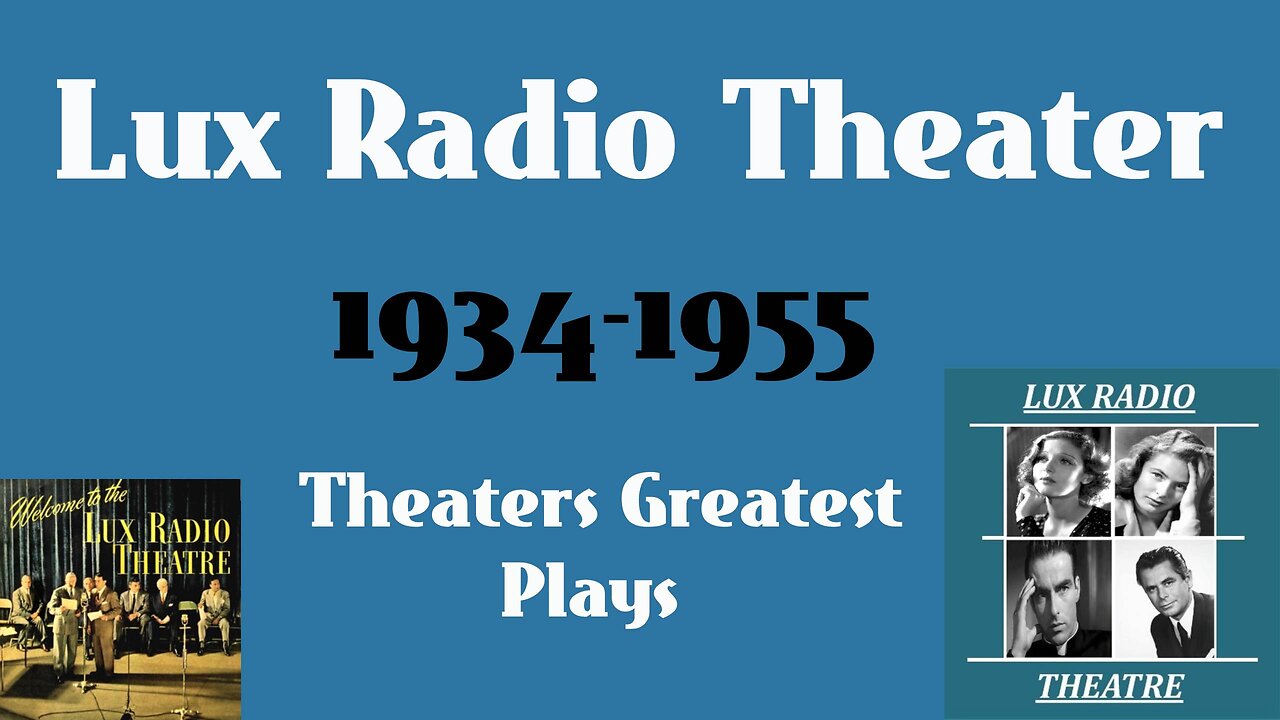Premium Only Content

Lux Radio Theatre 1936-12-21 ep112 Gold Diggers
The series begins with episode 52 Dulcy. None before this appear to exist.
Lux Radio Theatre was indisputably the biggest, most important, most expensive drama anthology program on radio. It ran from October 14, 1934, until June 7, 1955, then continued on television as Lux Video Theatre until 1957. In all, some 926 episodes were broadcast, providing a record of the most important entertainment events in American theatre and, later, film.
The show was first broadcast on the NBC Blue Network on Sundays at 2:30 PM. The show featured adaptations of successful Broadway plays when it was produced out of New York, such as Seventh Heaven, the first production starring Miriam Hopkins, Smilin' Through, Berkeley Square, Daddy Long Legs, Peg O' My Heart and Way Down East. On July 29, 1935, the show moved to Monday night at 9:00 PM on CBS, where it would stay until June 29, 1954.
The show moved to Hollywood on May 25, 1936 with the production of The Legionnaire and the Lady, based on the film Morocco, starring Marlene Dietrich and Clark Gable. The audience for this production was estimated as high as 40 million. The show featured many of the most important films of the period, adapted to fit the 60 minute time slot.
Some of the titles for 1939 should indicate the caliber and range of shows: Stage Door, Ceiling Zero, So Big, It Happened One Night, The Lives of a Bengal Lancer, Lady for a Day, The Life of Emile Zola, Tovarich, Only Angels Have Wings, The Prisoner of Zenda, The Awful Truth, Wuthering Heights, You Can't Take It With You, The Old Maid and Goodbye, Mr. Chips. For its last season, (1954-1955), the show moved to Tuesday nights at 9 on NBC.
Lux Radio Theatre was always broadcast live, with a studio audience and a full orchestra accompanying the performance and providing musical transitions between scenes. As many film actors were used to numerous takes and not live performance, they sometimes suffered acute stage fright before the show.
However, since most received $5,000 for their performance -- in addition to free publicity for upcoming pictures -- actors appeared in their original screen roles if they were available. Indeed, production would halt, if necessary, on a film if performers were called to appear on Lux. When the actors were not available, others stepped in.
The plays were assembled and rehearsed for a week, in sharp contrast to many other shows, which required a minimal of an actor's time. Regular players for the series included Jim and Marian Jordan, otherwise known as Fibber McGee and Molly. Hosts included Cecil B. DeMille (1936-1945), William Keighley (1945-1952) and Irving Cummings (1952-1955). Directors included Tony Stanford, Frank Woodruff, Fred MacKaye and Earl Ebi.
-
 3:11:00
3:11:00
TimcastIRL
4 hours agoTrump Kills 11 Narco Terrorists, Democrats Warn War With Venezuela Coming | Timcast IRL
133K118 -
 13:07
13:07
Robbi On The Record
3 days ago $7.77 earnedSweet Poison: The Big Fat Lie That’s Killing America
34.3K21 -
 LIVE
LIVE
Drew Hernandez
8 hours agoEPSTEIN VICTIMS SPEAK OUT & TRUMP DOUBLES DOWN
913 watching -
 1:36:41
1:36:41
FreshandFit
4 hours agoWe Are QUITTING YouTube...
34.4K30 -
 2:34:22
2:34:22
TheSaltyCracker
4 hours agoDrug Smugglers Blown Up 9-03-25
71.4K151 -
 3:12:59
3:12:59
VapinGamers
3 hours ago $0.01 earnedGrim Trials - Game Review/Playthru - Rougelight Dungeon Crawler - !rumbot !music
15.1K -
 2:47:55
2:47:55
Mally_Mouse
10 hours ago🎮 Let's Play!! -- Jak 2 pt. 16
30.9K2 -
 52:23
52:23
MattMorseTV
5 hours ago $0.63 earned🔴The Cartels are SCREWED.🔴
98.7K124 -
 1:32:46
1:32:46
Badlands Media
19 hours agoAltered State S3 Ep. 44: Epstein Files, Corrupt Judges, and the College Grift
41.4K1 -
 21:09
21:09
Bearing
16 hours agoAustralian “Racist” Protest EXPLODES 💥 Glowies, Brawls & Media Spin 📣
22.1K31